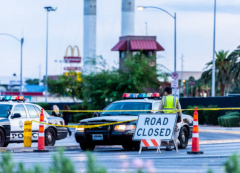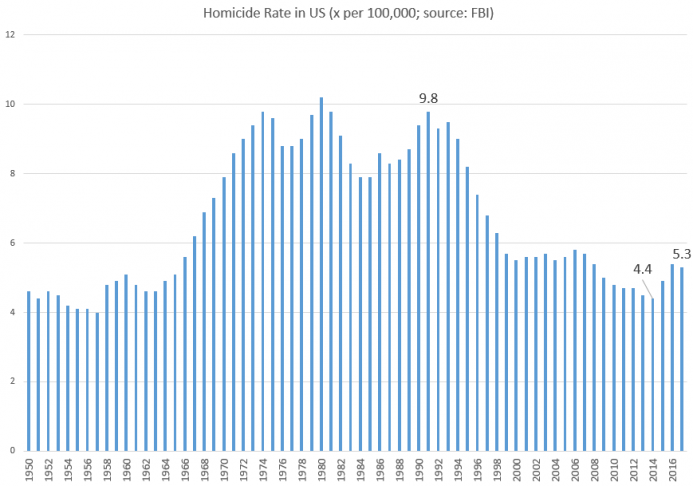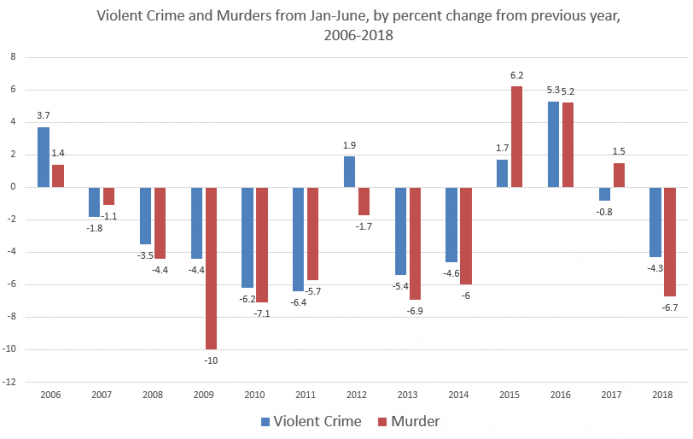Authored by Ryan McMaken via The Mises Institute,
Following the recent rash of mass shootings, media outlets have begun to suggest again that murder is a growing reality in the lives of Americans.
For example, the Associated Press ran an article titled “U.S. already has nearly 20 mass killings in 2019,” suggesting the threat of dying in a shooting is becoming an ever-more-likely fate in America. USA Today took it a step further with an article titled “Not an unreasonable fear: Mass shootings such as the one at Gilroy Garlic Festival more numerous, deadly.”
Articles like these combine to send to the message that homicides are a growing part of American life. Moreover, these sorts of articles have had the intended effect.
As the Pew Research Center has noted, [i]n a survey in late 2016, 57% of registered voters said crime in the U.S. had gotten worse since 2008. At least some of these poorly conceived estimates of crime trends can likely be attributed to an ongoing media focus on mass shootings. But as we shall see, mass shootings are but a very small part of larger crime trends. And, the overall trend has been downward for decades.
The homicide rate in America in recent years has been around half of what it was in the early 1990s.
Indeed, for Americans born in the 1970s or after, the last few years have been the least homicidal years of their lives.
It is true that nationwide homicide rates have increased since 2014’s 51-year low, rising from 4.4 homicides per 100,000 people in 2014 to 5.3 per 100,000 in 2017. But, the most recent data we have suggests 2018 may be another down year for homicides.1
According to preliminary crime data from the FBI for 2018, homicides and violent crime were both down in the first half of 2018, compared to the previous year.
Full-year stats for 2018 will become available in September.
From January to June of 2018, there were 6.7 percent fewer murders, and 4.3 percent less violent crime overall.
This decline follows a three year period during which murders rose form the previous year (in the first half of the year). But the preliminary data and the full-year data do not always match up. For example, the first half of 2017 showed an increase in homicides, although homicides ended up being down for the full year of 2017.
Trends can change at any time, of course. But for now, the data points toward a continued overall trend toward less homicide in the United States.
Nor is this trend just limited to homicides. This is important to note because sometimes observers of homicide data suggest homicides have only lessened because medical science means fewer assaults result in death.
But we can also see that violent crime in general — including aggravated assaults — are down considerably from earlier peaks.
Violent crime overall was at 382.9 per 100,000 during 2017, near a 45 year low.
Aggravated assaults were near a 40-year low, at 248.9 per 100,000.
It may very well be that medical science is helping prevent many assaults from turning into homicides, but it’s also true that fewer violent crimes in general are taking place. Thus, we cannot only attribute declines in homicide rates only to improved medical care for homicide victims. There are simply fewer violent attacks in America over the past twenty years.
What Role Do Mass Shootings Play?
In spite of all this, journalists and pundits who focus on mass shootings might say “well, the homicide rate would improve more if mass shootings weren’t such a problem.”
That may be so. But how much of the homicide puzzle are mass shootings? It turns out: very small.
According to Mother Jones magazine — a publication that’s hardly a right-wing stooge for the NRA — there were 117 deaths resulting from mass shootings in 2017. Given that there were 17,284 homicides reported during 2017, mass shootings made up 0.7 percent off all homicides.
In 2018, there were 80 deaths from mass shootings. We don’t have full-year 2018 data yet, but since the first half of the year already shows a 6.7 percent decrease, let’s assume a slight decrease for the year, down to 17,000 homicides. If this turns out to be the case, that means mass shooting deaths will make up about 0.5 percent of all homicides.
Those wounded in mass shootings are an even smaller percentage of those who survive serious assaults nationwide. Indeed, because aggravated assaults are so numerous, the non-homicide victims of mass shootings barely register as a percentage of total assaults. For example, in 2017, there were more than 810,000 aggravated assaults in the US. Even if we count the shockingly large number of wounded (i.e., 546 people) from the Las Vegas shooting that year, the total comes to 0.07 percent of all aggravated assaults.
Meanwhile, USAToday reports, 41% of Americans fear random mass shootings.
It remains unclear, however, why USAToday should label such concerns as “not an unreasonable fear.” True, it makes sense to not discount the risk of mass shootings entirely, and to be aware that the risk exists. Even if very small.
However, for all the air time and public discussion devoted to mass shootings in the US, nearly all people murdered in America this year will be murdered the “old fashioned” way. They’ll be murdered by a family member or a jilted lover or by some street thug looking to score some cash to pay for a drug fix. Most Americans murdered this year will victims of the sort we see in Baltimore where ordinary murders of the non-mass-shooting variety continue to wreak havoc on the local population. These murders won’t be any less tragic than murders from mass shootings. But you won’t hear nearly as much about them as you’ll hear about the mass shootings.
Of course, from a public policy perspective, it’s easy to see why pundits and politicians and media journalists would push the mass-shooting angle so hard. The seeming randomness of the shootings allows nearly the entire population to imagine that it could be a victim of a mass shooting at any time. After all, these shootings occur in churches and in schools and at county fairs. These are places where ordinary, middle class Americans go. More importantly, these are places voters go. It’s easy to look at street crime in a big city and dismiss it as simply a problem for people who live in “slums.” Thus, by focusing on mass shootings, its easier to create the impression that violence has exploded across the US, as mass shootings get ever more air time and discussion in social media.
Yes, it may very well be that trends reverse themselves, and we enter another cycle of rising crime in coming years. For now, however, most Americans’ estimates that crime is “getting worse” in the US appears to be unfounded.














